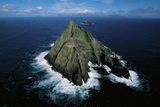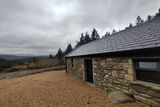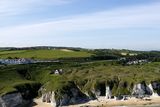Walk of the week: Omey Island, Co Galway
The water glittered like a million shards of glass as the falling tide sucked it back from the sands below Claddaghduff, revealing the causeway out to low-lying Omey Island.
Last time I crossed the tidal strand to Omey, it had been in the wake of a burial procession on a wild wet Connemara day. Black suits had flapped in the half-gale, the gulls had provided a keening choir, and the coffin was hoisted on the men's shoulders to its island resting place like a currach.
Today, blue skies lay over west Galway, with every islet and rock in the mouth of Clifden Bay picked out sharp and clear against a milky green sea. Instead of the creeping black insect shapes of the funeral cars, a line of trekking ponies processed jauntily out towards Omey, and we crunched and squelched after them over seaweed clumps and purple sheets of mussels.
By the time the ponies were trotting joyously through the surf, we had reached the island, whose shore boulders lay cracked and sea-smoothed like ancient sea beasts. Where their hide of black lichen had been abraded, dusky crimson rock showed through -- the distinctive hue of Omey's granite, contrasting with the pale-grey outcrops around Claddaghduff.
Looking back from the island, we saw the Twelve Bens rising in the east, a lumpy dark outline of mountain peaks and ridges.
We passed the old graveyard on the shore, its tall granite crosses facing the mainland, and walked the deserted road between walls of sparkly, rose-tinted granite, each stone a miniature rock garden of bushy lichens and pincushion mosses.
In the small walled fields and across the shell-sand, machair sward flowered orchids, moon daisies, pink sea thrift, sulphurous yellow clusters of bird's-foot trefoil, and -- incredibly for high summer -- violets and primroses, an island flora colourful beyond belief. The stark ruin of a house lay capsized in a sea of yellow flags, a herb garden of mint and wild thyme flourishing at the foot of its walls.
The road swung west and swooped over the brow of a low hill. Ahead rode the black and green shapes of islands out to sea -- pinnacled Cruagh, the tiny button of Carrickculloo, the bulkier outliers of Friar Island and the pilgrims' goal, High Island. White teeth of breaking waves gnawed at their flanks and tossed around the sleek black shape of a currach that was battling out to High Island. A low roaring came to us, showing the strength of the wind out there beyond the sheltering loom of the land.
Nearer at hand, five swans rode the smooth waters of Fahy Lough. We passed along the beautiful white sand curve of Trá Rabhach, the 'fruitful strand', and hunted among rocks patched with ring-shaped lichens until we stumbled across Tobair Feichín. The holy well, dedicated to the 7th-century Sligoman who set up a monastery on Omey, was bright with offerings; its spring crevice lay damp, and sea thrift covered everything in a blur of pink.
Beyond, sunk in a dune, we found a roofless church dedicated to St Feichín, its rough granite walls hidden in the sandhills. A fragment of human skull lay in the aumbry. The lime-rich sand that underlies Omey's flowery sward is dense with bonemeal, the legacy of thousands of years of burials.
Feichín seems to have been a moody man. Once, dissatisfied with his reward for herding St Ciarán's oxen, he stomped off in a strop. When summoned to return and bury the hatchet, the sulky saint made his appearance walking backwards so he wouldn't have to look Ciarán in the eye. Such details make our saints and heroes appealing in their human fallibility -- so we thought, anyway, as we took the shore path for the causeway and the promise of a nice pint above in Sweeney's fine emporium.
csomerville@independent.ie
Join the Irish Independent WhatsApp channel
Stay up to date with all the latest news














